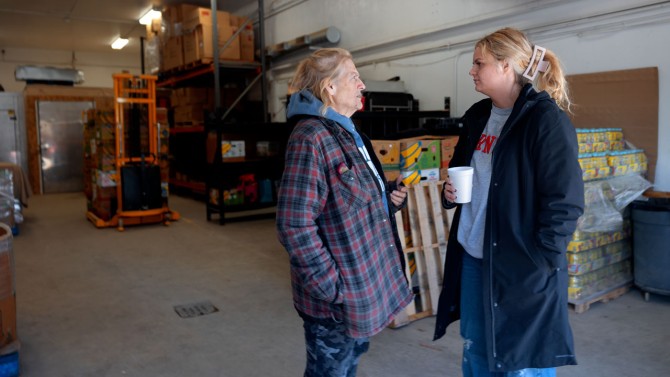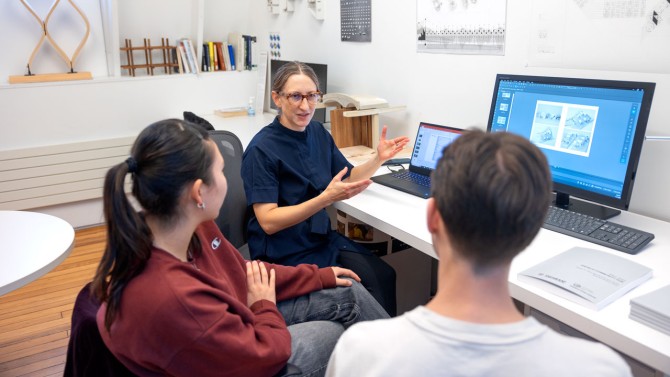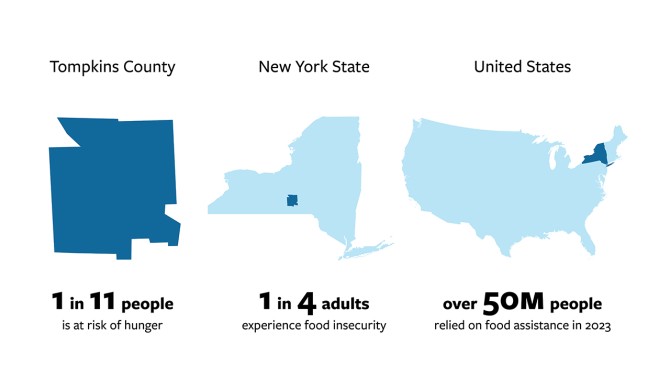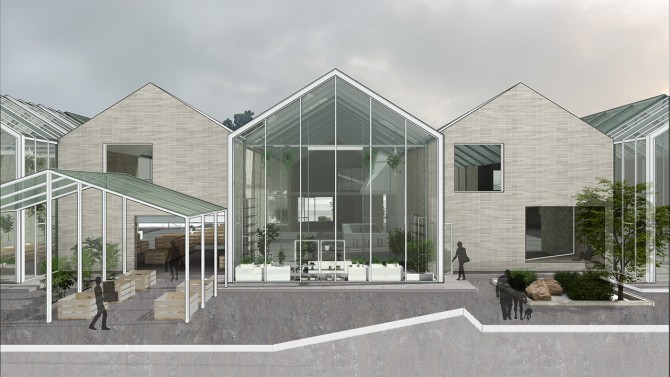Supported by a grant from the Einhorn Center for Community Engagement, Enfield Food Distribution is partnering with Cornell experts to create a resource hub for growing community needs.
Pantry collaboration expands mission to fight food insecurity
By James Dean, Cornell Chronicle
Frost glistened outside as the first of roughly 200 patrons wound through Enfield Food Distribution on a recent Sunday morning, loading shopping carts with fresh produce, canned goods, potatoes and onions, meat, bakery items, bottled water, and for some, a bouquet of flowers.
Occupying a 1948 former fire house on Enfield Main Road, eight miles west of Ithaca, the pantry served as many clients in an entire week just a few years ago. But as the pandemic shuttered other sites, Jean Owens, Enfield’s director, and a team of volunteers began welcoming all comers, taking online orders and packing boxes for drive-through pickup. Demand quickly tripled to 600 customers per week, some lining up two hours before opening on winter days, some traveling as far as 50 miles.
“I had to stop people from coming the night before and camping,” Owens said.
Over the last several years, a team of Cornell faculty and students has been helping Owens meet that growing need – which has been exacerbated by inflation – and advance her vision for the future. Distributing 2 million pounds of food annually now strains the center’s capacity, and its scant parking, proximity to an active fire station and frontage on a road with high-speed traffic create safety concerns. On agricultural land up the road, she hopes to build a new, larger structure that not only distributes food but serves as a community resource hub, empowering guests with gardens, nutrition classes, a kitchen and other programs.
Offering policy, engineering and design expertise, the Cornell team, now supported by a grant from the Einhorn Center for Community Engagement, has helped Owens develop a strategic plan, strengthen governance, register as a nonprofit and apply for grants, and proposed designs for the new facility, including architectural concepts and analyses of how to organize it most efficiently.
“I can’t tell you how many hours I put in towards just meeting the basic day-to-day needs of the pantry,” said Owens, who was in the process of securing as many as 800 turkeys to distribute before Thanksgiving. “But our facility is inadequate to continue to do that. The Cornell partnership has helped develop opportunities to find the funding we need and to design a new facility that can continue to serve for decades to come.”
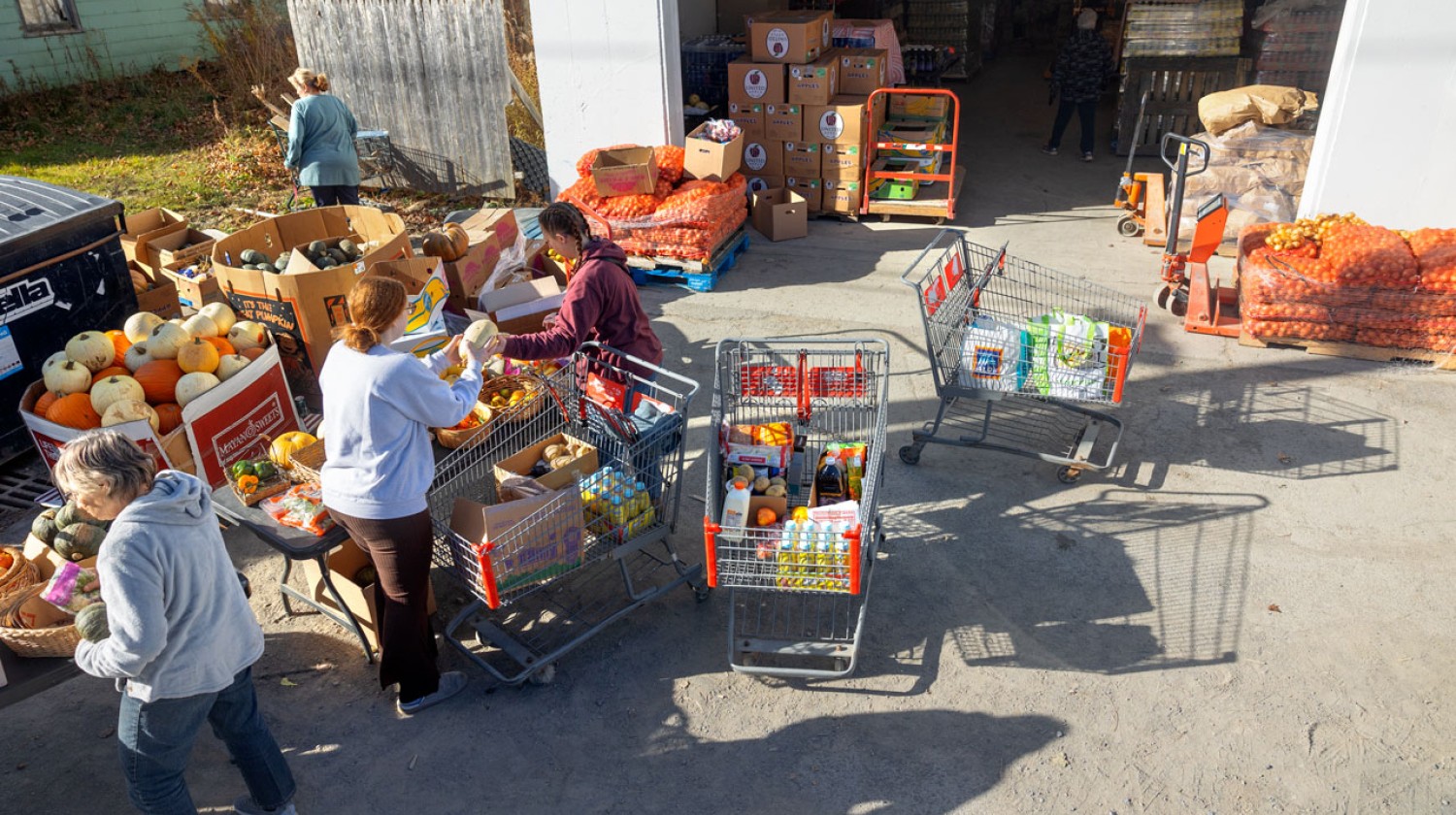
Offering fresh produce in addition to canned goods, meat and dairy items, Enfield Food Distribution welcomes 600 patrons weekly and provides 2 million pounds of food annually.
For Courtney Braun, a second-year Master of Public Administration student in the Cornell Jeb E. Brooks School of Public Policy, specializing in nonprofit and public management, the project resonates deeply. Braun experienced homelessness and hunger as a teenager, frequenting food pantries throughout her undergraduate studies in Texas. Now she’s helping Owens with fundraising and coordinating the university collaboration led by Laurie Miller, senior lecturer in the Brooks School and the MPA program’s associate director for public engagement. Joining them in weekly meetings are David Goldberg, associate professor in Cornell Engineering’s School of Operations Research and Information Engineering (ORIE), and his students; and Hanna Tulis, lecturer in the Department of Architecture in the College of Architecture, Art and Planning.
“It’s such a personal journey for me,” Braun said as patrons – from seniors to families with young children – navigated narrow aisles stacked high with boxes and crates of provisions. “I feel like just yesterday it was me. Sometimes that’s hard to believe, because I go to Cornell and look a typical college student. But the reality is just two years ago I was trying to get resources at my school’s food pantry.”
Food insecurity often is hidden from view, the collaborators say, affecting people with homes, jobs and cars but little margin to buy food that’s gotten significantly more expensive. In Tompkins County, 1 in 11 individuals are at risk of hunger, according to the Food Bank of the Southern Tier. Statewide the self-reported total is 1 in 4 – ranging from 11% to 39% by county – according to the New York State Department of Health. And nationally last year, more than 50 million people sought food assistance, according to Feed America.
James Luoma, of Enfield, has been utilizing the local pantry since he had to stop working in 2017.
“Money is pretty tight,” said Luoma, 71, who pushed a canister of oxygen alongside his groceries. “I’m not going to starve to death if I went without this, but it sure helps.”
Susie Perin, a volunteer from Ithaca, benefited from the pantry during the pandemic, when she was not working and her husband was ill. Now in addition to weekend shifts in Enfield, she regularly drives food to a wheelchair-bound local resident, a single mother and a foster family.
“It was such a huge help to our lives that I wanted to give back,” Perin said. “Jean is kind to people at some of their worst moments, and I think they don’t forget that.”

Some 40 volunteers support Enfield Food Distribution’s mission. Having outgrown its current space in an old fire house, the pantry is raising funds to design and build a community hub on a new site, aided by Cornell faculty and students. The collaboration is supported by the Einhorn Center for Community Engagement.
Nearby, Qingyuan “Amber” Chen, an ORIE doctoral student, kept a log of arriving clients and the number of people they were shopping for, while undergraduates Jijuan Xu ’26, of New York City, and Ian Yang ’25, of Singapore, tracked the time shoppers spent at each station. The information will improve models that aim to optimize how people and vehicles flow through the proposed new site. Gathering produce, meat and dairy took more time than canned goods, they found – unless clients also stopped at an adjacent clothing station.
The ORIE researchers said they appreciated engaging in an applied, hands-on challenge outside the classroom that could help a community partner. And, for those who haven’t experienced it, gaining a more direct understanding of food insecurity.
“Intellectually, you know the need is there, but actually being here in person, you have an experience and faces to put to that experience,” Xu said. “That’ll stay with you. And then you realize, this could just as easily be me.”
Last spring, a class of 60 third-year architecture students produced creative design concepts for the proposed community resource hub that the faculty reviewed with Owens. Next semester, a new class will build on aspects that most appealed to Owens and incorporate the engineering simulations and more detail about anticipated space and budget constraints.
“It’s great for our students to have the opportunity to engage with these ideas early in their training,” Tulis said. “This is a unique opportunity where a building can solve a lot of the issues with pantry users’ experience in the current space. Jean wants to lend dignity to that experience through architecture.”
A first application for a large foundation grant to support facility construction, crafted with help from several Brooks School students, was unsuccessful, but Owens has been invited to reapply.
“I am totally secure in the fact that we’re going to develop designs and answers to all these questions we have with accessibility and parking, and the ability to welcome people in,” Owens said. “This isn’t just feeding people. It’s making people feel like they’re part of a community and there’s support for them here.”
Media Contact
Get Cornell news delivered right to your inbox.
Subscribe